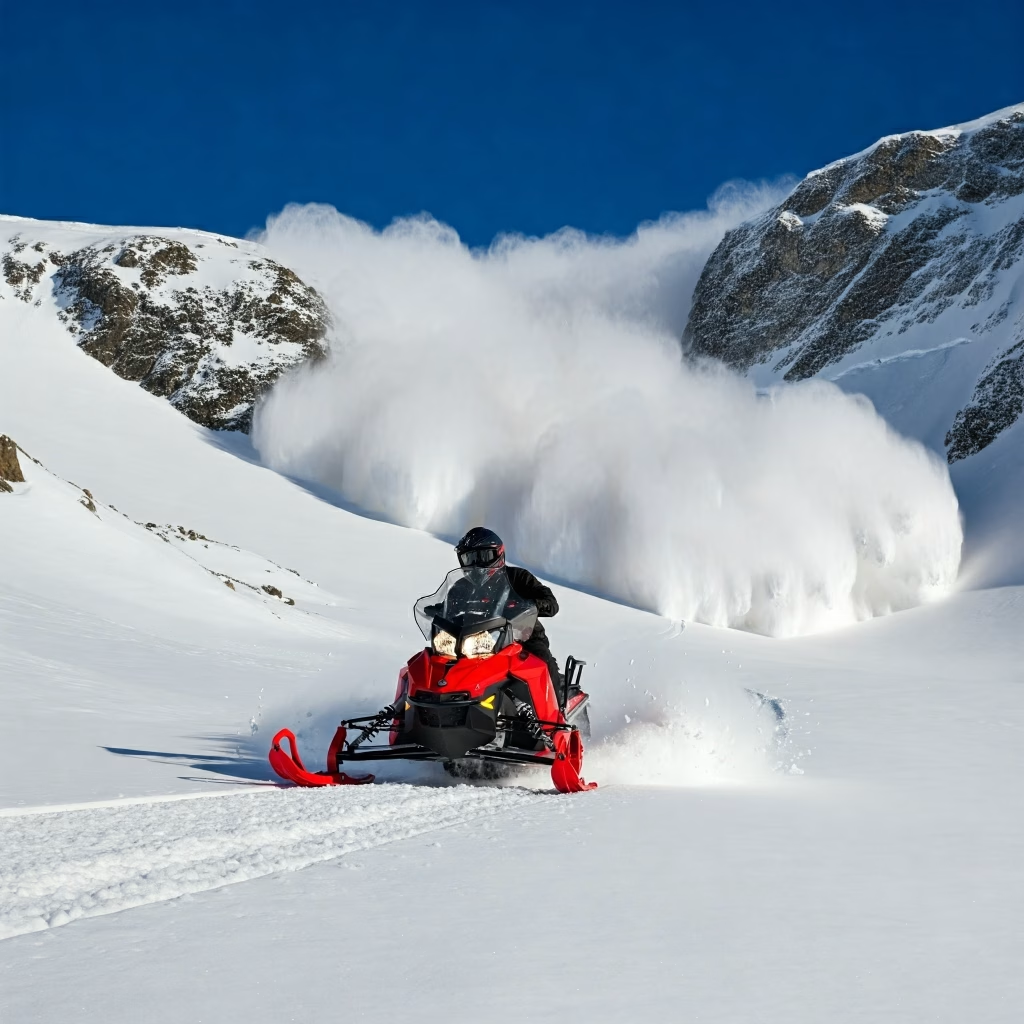
Riding the Powder Wave: Your Ultimate Guide to Snowmobile Safety and Avalanche Awareness
Snowmobile Safety and Avalanche Awareness: The thrill of carving through fresh powder on a snowmobile is an experience like no other. But with this exhilarating adventure comes responsibility. Understanding avalanche safety and responsible snowmobiling practices is crucial for a safe and enjoyable ride. This comprehensive guide will equip you with the knowledge and resources you need to navigate the backcountry with confidence.
Understanding Avalanches Awareness: Nature’s Unpredictable Force
Avalanches are sudden, rapid flows of snow down a slope, and they can be triggered naturally or by human activity. They are a significant danger in mountainous regions, particularly during and after heavy snowfall. Recognizing avalanche terrain and understanding the factors that contribute to their formation is the first step towards mitigating risk.
Key factors influencing avalanche formation:
- Snowpack: Weak layers within the snowpack can act as slip surfaces, making the slope unstable.
- Terrain: Steep slopes, particularly those between 30 and 45 degrees, are prime avalanche territory.
- Weather: Recent snowfall, rain, or rapid temperature changes can increase the stress on the snowpack.
Essential Gear for Avalanche Safety
Venturing into the backcountry requires specific safety equipment. This gear is not just recommended; it’s essential for your survival in case of an avalanche.
- Avalanche Transceiver: This device sends and receives signals, helping locate buried individuals. Practice using your transceiver regularly to ensure proficiency in an emergency.
- Shovel: A sturdy shovel is crucial for digging out a buried companion. Choose a collapsible model for easy packing and a durable blade for efficient snow removal.
- Probe: This collapsible pole helps pinpoint the exact location of a buried victim. Practice assembling and using your probe swiftly.
- Avalanche Airbag Pack: This backpack inflates with the pull of a cord, increasing your chances of staying near the surface of an avalanche. It’s an invaluable tool for increasing survivability.
- Helmet: A well-fitted helmet is essential for protecting your head from impacts in an avalanche or during a fall.
- First-Aid Kit: Carry a comprehensive first-aid kit to address injuries in the backcountry.
- Communication Devices: A cell phone or satellite phone can be crucial for calling for help in an emergency. However, remember that cell service may be unreliable in remote areas.
- Extra Layers and Food: Pack extra layers of warm clothing and high-energy snacks in case you get stranded or delayed.
Pre-Trip Planning: Your Foundation for Safety
Before heading out, meticulous planning is crucial. This includes assessing the avalanche risk, informing someone about your plans, and checking the weather forecast.
- Avalanche Forecast: Always check the avalanche forecast for your intended riding area. These forecasts provide crucial information about current conditions and potential hazards. You can usually find this information online or at local ranger stations.
- Route Planning: Plan your route carefully, considering terrain features, potential hazards, and escape routes. Share your itinerary with someone who is not going on the trip.
- Group Dynamics: Ride with a partner or group, and ensure everyone has the necessary snowmobile safety gear and avalanche awareness knows how to use it. Discuss emergency plans and communication strategies.
Recognizing Avalanche Terrain
Identifying avalanche terrain is a crucial skill for backcountry riders. Look for these telltale signs:
- Steep Slopes: Slopes between 30 and 45 degrees are most susceptible to avalanches.
- Convex Slopes: Outwardly curved slopes are more likely to avalanche than concave slopes.
- Terrain Traps: Gulleys, depressions, and trees can increase the consequences of being caught in an avalanche.
- Recent Avalanche Activity: Look for signs of recent avalanches, such as debris piles or fracture lines.
- Wind-Loaded Slopes: Wind can transport snow and create unstable slabs on leeward slopes.
On the Trail: Practicing Safe Riding Techniques
While riding, maintain situational awareness and adjust your behavior based on the conditions.
- Safe Riding Practices: Avoid risky terrain, especially during periods of high avalanche danger. Travel one at a time across steep slopes and maintain a safe distance between riders.
- Observation and Communication: Continuously observe the terrain and snow conditions. Communicate with your riding partners and share any concerns.
- Changing Conditions: Be prepared to adjust your plans if conditions change or if you encounter unexpected hazards.
If the Worst Happens: Avalanche Rescue Procedures
Despite all precautions snowmobile safety and avalanche awareness. Avalanches can still occur. Knowing how to respond quickly and efficiently can significantly increase the chances of survival.
- Self-Rescue: If caught in an avalanche, try to escape to the side or grab onto a tree. If buried, try to create an air pocket around your face.
- Companion Rescue: If your partner is buried, begin a transceiver search immediately. Follow the signal to the burial site, then use your probe to pinpoint the victim’s location. Begin digging with your shovel, working quickly and efficiently.
- Professional Rescue: If you cannot locate or extricate the victim, call for help immediately. Provide clear and concise information about your location and the situation.
Resources for Continued Learning
Avalanche safety education is an ongoing process. Here are some valuable resources to enhance your knowledge and skills:
- Avalanche Safety Courses: Taking an avalanche safety course from a certified instructor is highly recommended. These courses provide hands-on training in avalanche awareness, rescue techniques, and decision-making.
- Online Resources: Several websites and organizations offer valuable information about avalanche safety, including avalanche forecasts, educational materials, and safety tips.
- SledManuals.com: This website provides a wealth of information about snowmobile maintenance, repair, and safe riding practices. It’s a valuable resource for snowmobile safety any snowmobiler.
Snowmobile Safety Maintenance: Ensuring a Safe and Reliable Ride
Proper snowmobile maintenance is crucial not only for performance but also for safety. Regular upkeep can prevent breakdowns and malfunctions that could put you at risk in the backcountry.
- Pre-Ride Check: Before each ride, inspect your snowmobile thoroughly. Check the track, brakes, lights, and fluid levels. Ensure all components are in good working order.
- Regular Maintenance: Follow the manufacturer’s recommended maintenance schedule. This includes oil changes, filter replacements, and belt inspections.
- Storage: When storing your snowmobile for an extended period, take steps to protect it from the elements. This includes draining the fuel, removing the battery, and covering the machine.
Responsible Riding: Minimizing Your Impact
Snowmobiling can have an impact on the environment and wildlife. Practicing responsible riding habits helps minimize your footprint and preserve the backcountry for future generations.
- Stay on Designated Trails: Avoid riding off-trail, as this can damage vegetation and disturb wildlife.
- Respect Wildlife: Observe animals from a distance and avoid disturbing their natural behavior.
- Pack Out Your Trash: Leave no trace of your presence. Pack out all trash and litter.
- Minimize Noise: Excessive noise can disrupt wildlife and detract from the enjoyment of other recreationists.
Conclusion
Snowmobiling is an incredible way to experience the beauty and thrill of winter. By prioritizing snowmobile safety, educating yourself about avalanche awareness, and practicing responsible riding habits, you can enjoy this exhilarating sport while minimizing risks and preserving the environment. Remember, knowledge is your most powerful tool in the backcountry. Stay informed, stay prepared, and ride safe.
Share this:
- Click to share on Facebook (Opens in new window) Facebook
- Click to share on X (Opens in new window) X
- Click to share on Reddit (Opens in new window) Reddit
- More
- Click to share on LinkedIn (Opens in new window) LinkedIn
- Click to share on Mastodon (Opens in new window) Mastodon
- Click to share on X (Opens in new window) X
- Click to share on Pinterest (Opens in new window) Pinterest
- Click to share on Threads (Opens in new window) Threads
- Click to share on Bluesky (Opens in new window) Bluesky
- Click to share on Tumblr (Opens in new window) Tumblr
- Click to email a link to a friend (Opens in new window) Email
- Click to share on Pocket (Opens in new window) Pocket
- Click to share on Telegram (Opens in new window) Telegram
- Click to share on WhatsApp (Opens in new window) WhatsApp
- Click to share on Nextdoor (Opens in new window) Nextdoor
